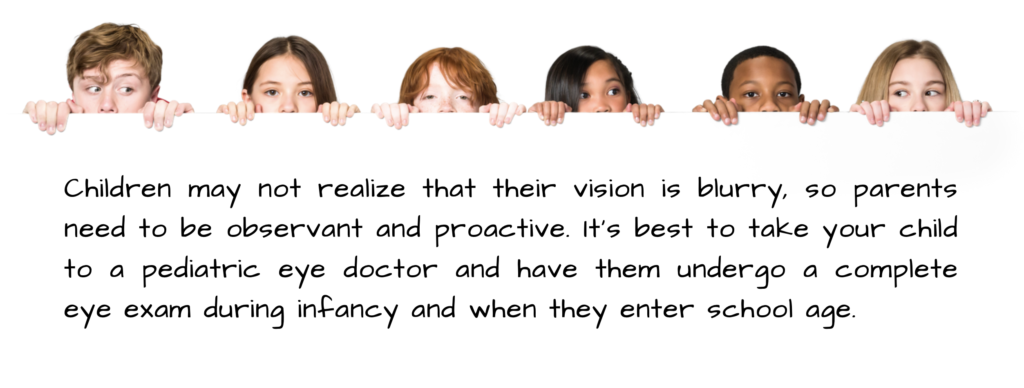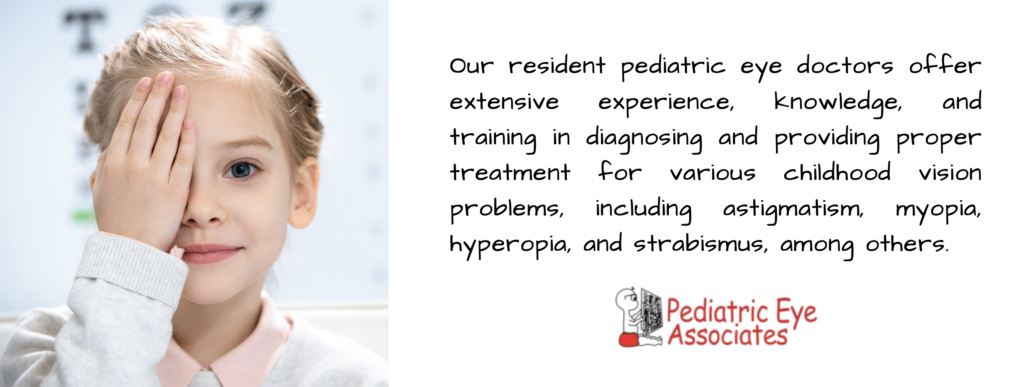Astigmatism is considered to be one of the most misunderstood vision problems in children. It is also the most common refractive error seen for preschoolers that can occur with myopia. Astigmatism occurs due to an abnormal curvature of the eyeball. This means that when the light enters into the eyes it’s not correctly distributed to the retina, resulting in blurry vision. A recent study shows that children in America aged 5-17 have a 28% chance of being afflicted with astigmatism.
Our pediatric eye doctor will discuss important information you should know about your child’s astigmatism, such as its causes, signs and symptoms, types, and treatment.
What is astigmatism?
Similar to nearsightedness (myopia) and farsightedness (hyperopia), astigmatism is classified as a refractive error. As such, it is not an eye disease but rather an eye abnormality that is a result of the imperfection of the eye’s curvature.
Astigmatism occurs when the cornea (the transparent cover of the front portion of the eye) or the lens in the eye is abnormally curved. A normal eye should be round. If the cornea is shaped otherwise, the curvature distorts the light rays that enter the eye. As a result, the light projected onto the retina is distorted and the person sees distorted and blurred images.
In children, astigmatism may be present at birth. However, it can also develop after an eye injury or a surgery done to correct another eye disease or condition.
What are the causes of astigmatism?
Astigmatism is caused by an abnormal curvature of the cornea, of the lens or both. Cornea is the transparent layer on the outside of the eyes, its main function is to transmit and focus the entry of light into the eye. A healthy cornea can properly retract light that enters in the eye. A child with astigmatism has an egg-shaped cornea, which has two different curves, causing blurred vision and other symptoms.
While astigmatism is caused by the curvature in the eye’s cornea, lens, or both, there is no exact cause behind the curvature itself. In general, there are several factors that make a child more susceptible to developing astigmatism, such as:
-
Family history
If astigmatism and other eye health conditions run in the family, it’s possible for a child to develop it too.
-
Having other refractive errors
The presence of other refractive errors (nearsightedness or farsightedness) also increases a child’s susceptibility to developing astigmatism.
-
Maternal smoking
Studies have suggested that children whose mothers smoked during pregnancy are more likely to get astigmatism.
-
African-American, Asian, or Hispanic heritage
Previous studies done on preschool children with astigmatism show a pattern that African-American, Asian, and Hispanic subjects were at a higher risk of having astigmatism compared to other ethnicities.
What are the signs and symptoms?
If you have observed any of the following signs and symptoms in your children, you should have them checked by a certified pediatric ophthalmologist.
- Distorted or blurred vision
- Fatigue or eye strain
- Headaches
- Squinting
- Vision difficulty at night
What are the types of astigmatism?
There are three types of of astigmatism:
-
Lenticular astigmatism.
Affects the lens instead of the cornea. The lens allows the images to reach the retina, and this type of astigmatism makes it have variations.
-
Myopic astigmatism.
This type of astigmatism happens when astigmatism and nearsightedness are combined, causing the two curves to focus in front of the retina.
-
Hyperopic astigmatism.
This happens when farsightedness is combined with astigmatism, causing the two curves to focus behind the retina.
-
Mixed astigmatism.
When one eye is farsighted, while the other is nearsighted
Astigmatism can also be classified as regular or irregular:
- Regular astigmatism means that the two curves are 90 degrees apart, while irregular astigmatism is not 90 degrees apart from each other.
- Irregular astigmatism can be caused by an eye injury, eye trauma, surgery or an eye condition called keratoconus, which makes the cornea gradually thinner.
How common is astigmatism in children?
Astigmatism is actually very common among children. According to a study by researchers from the American Academy of Ophthalmology, around 23% of children aged 6 months to 1 year have it. Fortunately, most of them outgrow it, which is why the percentage of children aged 5 to 6 years old with astigmatism drops down to only 9%.
Can astigmatism increase the risk for amblyopia?
Sadly, yes — severe astigmatism is considered a risk factor for amblyopia, the leading cause of vision loss in children that is also more commonly known as lazy eye. This was made official by the revised guidelines from the American Association for Pediatric Ophthalmology and Strabismus (AAPOS) which was issued in 2012. The AAPOS guidelines also recommend that children aged 1 to 4 years old should be tested by a pediatric eye doctor for astigmatism greater than 2 diopters, while older children must be checked for astigmatism greater than 1.5 diopters.
Can astigmatism be corrected?
Yes. Astigmatism can be corrected with the help of timely and proper diagnosis, which leads to the correct management and treatment of the condition. Moreover, parents must keep in mind that even though prescription eyeglasses or contact lenses are generally used to correct astigmatism, it is not always necessary for very young children. This is because a slight degree of astigmatism that is not accompanied by myopia or hyperopia may improve on its own as the child grows.
After thorough testing, your pediatric eye doctor will be able to determine whether your child has astigmatism or other eye conditions, and if they need corrective lenses.
Make no mistake, however. Even if childhood astigmatism improves over time, it is still a good idea to have your child undergo regular eye exams.
If ignored and not properly treated, astigmatism can lead to other vision problems, the worst of which is vision loss. If you notice that your child is showing signs of astigmatism, make sure to schedule an appointment with a pediatric eye doctor near you.
How is astigmatism in children diagnosed?
Children may not realize that their vision is blurry, so parents need to be observant and proactive. It’s best to take your child to a pediatric eye doctor and have them undergo a complete eye exam during infancy and when they enter school age. In general, the eye doctor will tell you when to bring your child for their next eye exam.
How is an eye exam done?
A complete eye exam is a series of tests designed to check the eye’s refraction and overall health. The eye doctor will use various instruments to test different aspects of the child’s eye and vision. The findings will eventually determine how the child’s eyes bend light and whether they need prescription lenses or not.
What are the treatment options for your children?
Astigmatism can mostly be corrected by the use of glasses, contacts or refractive surgery. These treatment options are best discussed with your child’s ophthalmologist to help you decide which one is best for your child.
-
Eyeglasses.
This is the most common corrective tool. Your child’s eye doctor will prescribe cylinder types of lenses to correct the astigmatism.
-
Contact lenses.
Correcting lenses for astigmatism are called toric lenses, they’re mostly prescribed for low-grade astigmatism. Glass permeable contact lenses can also be another option – the same is true with hybrid contact lenses.
-
Refractive surgery.
This is a laser surgery that corrects the shape of the eye.
Pediatric Eye Associates – Home to Friendly and Certified Pediatric Eye Doctor in Livingston, NJ
If you are on the web searching for a “pediatric eye doctor near me” then you’ve come to the right place. Pediatric Eye Associates have pediatric ophthalmologists who are board certified and specialize in diagnosis, evaluation and treatment of your child’s medical, and surgical eye conditions and disorders.
Our resident eye doctors for children offer extensive experience, knowledge, and training in diagnosing and providing proper treatment for various childhood vision problems, including astigmatism, myopia, hyperopia, and strabismus, among others.
To get the highest quality eye care for your children, visit our office in Livingston, NJ. Contact us today to learn more and schedule an appointment.
The material contained on this site is for informational purposes only and DOES NOT CONSTITUTE THE PROVIDING OF MEDICAL ADVICE, and is not intended to be a substitute for independent professional medical judgment, advice, diagnosis, or treatment. Always seek the advice of your physician or other qualified healthcare provider with any questions or concerns you may have regarding your health.


